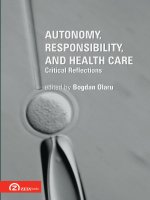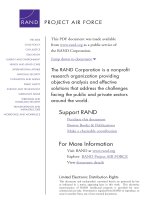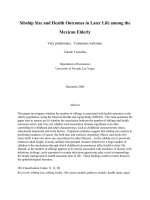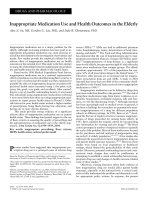Remodelling Hospitals and Health Professions in Europe potx
Bạn đang xem bản rút gọn của tài liệu. Xem và tải ngay bản đầy đủ của tài liệu tại đây (625.24 KB, 225 trang )
Mike Dent
Remodelling Hospitals
and Health Professions
in Europe
Medicine, Nursing and the State
Remodelling Hospitals and Health Professions in Europe
Other recent titles also by Mike Dent
MANAGING PROFESSIONAL IDENTITIES: Knowledge, Performativity and the
‘New’ Professional (co-editor – Stephen Whitehead)
GENDER AND THE PUBLIC SECTOR (co-editors – Jim Barry and Maggie
O’Neill)
Remodelling Hospitals
and Health Professions
in Europe
Medicine, Nursing and the State
Mike Dent
Professor of Health Care Organisation
Staffordshire University
© Mike Dent 2003
All right reserved. No reproduction, copy or transmission of this
publication may be made without written permission.
No paragraph of this publication may be reproduced, copied or transmitted
save with written permission or in accordance with the provisions of the
Copyright, Designs and Patents Act 1988, or under the terms of any licence
permitting limited copying issued by the Copyright Licensing Agency,
90 Tottenham Court Road, London W1T 4LP.
Any person who does any unauthorised act in relation to this publication
may be liable to criminal prosecution and civil claims for damages.
The author has asserted his right to be identified as
the author of this work in accordance with the Copyright,
Designs and Patents Act 1988.
First published 2003 by
PALGRAVE MACMILLAN
Houndmills, Basingstoke, Hampshire RG21 6XS and
175 Fifth Avenue, New York, N.Y. 10010
Companies and representatives throughout the world
PALGRAVE MACMILLAN is the global academic imprint of the Palgrave
Macmillan division of St. Martin’s Press, LLC and of Palgrave Macmillan Ltd.
Macmillan® is a registered trademark in the United States, United Kingdom
and other countries. Palgrave is a registered trademark in the European
Union and other countries.
ISBN 0–333–76067–0 hardback
This book is printed on paper suitable for recycling and made from fully
managed and sustained forest sources.
A catalogue record for this book is available from the British Library.
Library of Congress Cataloging-in-Publication Data
Dent, Mike, 1944–
Remodelling hospitals and health professions in Europe : medicine, nursing, and
the state Mike Dent.
p. cm.
Includes bibliographical references and index.
ISBN 0–333–76067–0
1. Medical care—Europe. 2. Nursing—Europe. 3. Social medicine—
Europe. I. Title.
RA395.E84M556 2003
362.1Ј094—dc21
2003048275
10987654321
12 11 10 09 08 07 06 05 04 03
Printed and bound in Great Britain by
Antony Rowe Ltd, Chippenham and Eastbourne
Contents
List of Figures and Box vii
Glossary of Foreign Terms, Abbreviations and Acronyms viii
Acknowledgements xv
1 Reorganising Hospital Medicine and Nursing
in Europe 1
The changing policy context 1
The organisation of the book and selection of countries 6
A note on the methods of inquiry 7
Concluding remarks 8
2 European Hospitals, Medicine, Nursing and
Management 9
Welfare state regimes and health care systems 9
The medical and nursing professions 12
European hospitals, organisations and New Public
Management 31
Conclusions 41
3 The Netherlands and Sweden: Quality Control 43
The health systems, hospitals and the reforms in
Netherlands and Sweden 45
Professional organisation of medicine and clinical
governance 55
Hospital nursing, professional aspirations and
management 66
Conclusions 75
4 The United Kingdom and France: Étatiste
Traditions 76
Hospitals and health systems: UK and France 78
Hospital doctors, the medical profession and governmentality 85
Quality assurance and clinical governance 92
v
Hospital nurses: extended roles and professional boundaries 98
Conclusions: the UK and French state and nursing 109
5 Germany and Italy: Federalism and Regionalism 111
Health care reforms, hospital doctors and organisational
change in Germany and Italy 112
Nurse work and professional organisation 132
Germany and Italy: comparisons and conclusions 140
6 Poland and Greece: Transition or Embeddedness? 143
Healthcare reforms and hospital doctors 146
Nursing: gender, familialism and clientelism 165
Conclusions 169
7 Conclusions: Figuring Out the State of
Professionalisation within European Health Care 170
Patients, nurses and doctors in Europe 172
Final comments 178
Notes 180
Bibliography 185
Subject Index 201
Author Index 207
vi Contents
vii
List of Figures and Box
Figures
2.1 European welfare state regimes and health care systems 13
2.2 A typology of welfare state regimes 17
2.3 Subsidiarity, familialism and clientelism 20
3.1 Main organisations in the ‘policy community’ of quality in
health care in Sweden 62
4.1 Quality assurance systems for hospital medicine in the UK 94
6.1 Uncoupled autonomy and professionalism 165
7.1 Loose coupling, professionalism and managerial control 176
Box
5.1 Modernity through FIT 117
Glossary of Foreign Terms,
Abbreviations and Acronyms
Dutch
AVVV – General Assembly of Nursing and Allied Health Professional
Groups.
CBO National Organisation for Peer Review in Hospitals.
KNMG – Royal Dutch Medical Association
LCVV – National Centre for Nursing and Care – a federation of profes-
sional nursing and care providers funded by the government.
Maatschappelijk middenveld – the ‘middle field’ where the government
has some power as well as responsibility for balancing out the claims
of the various interest groups in order to represent a consociational
public interest – approximating to a national interest.
maatschappen – the independent partnerships of hospital specialists.
A form unique to the Netherlands.
Nieuwe Unie – NU’91 – National Nurses Association of the Netherlands.
NIVEL – The Netherlands Institute for Primary Health Care.
NIZW – The Institute for Care and Welfare.
NZI – National Hospital Institute.
VERVE – Society of Nursing Scientists.
verzuiling – ‘pillarisation’ of society. This peculiarly Dutch institu-
tional arrangement formally established in the early part of the
twentieth century has effectively enabled Catholics, Protestants
and secularist interests to co-exist within a coalition of social
solidarity.
Wet BIG – Individual Health Care Professions Act.
French
Agence Nationale Pour le Développemment de l’Evaluation Médicale
(ANDEM) – National agency for the development of medical guide-
lines and evaluation.
ANAES (Agence Nationale d’Accreditation et d’Evaluation) – Nationale
Agency for Accreditation and Evaluation responsible for accreditation
across the public and independent sectors.
viii
Glossary of Foreign Terms, Abbreviations and Acronyms ix
Association Française des Infirmiéres Diplômés et Élèves (ANFIIDE) –
Association of French Nurses – The main organisation for public
sector hospital nurses established 1924
Assurance-Maladie – the statutory health insurance – sickness fund –
system.
Brevet de Capacité Professionel – Nursing Certificate and legal qualification
to practice.
cadres supérieurs infirmiers, the nursing managers at ward level.
Caisse National d’Assurance Maladie des Travailleurs Salariés (CNMATS) –
the National Sickness Fund, which is under state control.
Caisses Primaires d’Assurance Maladie – Primary Sickness Funds.
Caisses Régionale d’Assurance Maladie – Regional Sickness Funds.
carte sanitaire – ‘health map’ of 200 geographical health sectors for
determining health needs and provision of hospitals and clinics.
chef de service – head (chief) doctor of a hospital speciality or service with
responsibility to provide medical leadership.
Conféderation des Sydicats Médicaux Français (CSMF) – Confederation of
Medical Unions of France
Confédération Français démocratique du travail (CFDT) – Democratic union
for white-collar and technical workers (historically a Catholic union)
Confédération générale du travail-Force ouvrière (CGT-FO) – General
union of industrial workers/working class (historically the communist
union for manual workers).
directeur des soins – director of care.
droits – rights
étatisme and étatiste – highly centralised state organisation, particularly
associated with France.
Fédération des Médecins de France (FMF) – Federation of the Physicians of
France.
Fédération des Sydicats Médicaux de France (FSMF) – Federation of the
Medical Unions of France.
hôpital-entreprise – Hospital enterprise.
infirmier anesthésiste – anaesthetic nurse
infirmier de bloc opératoire – theatre nurse,
Infirmier Generale – Director of Nursing – literally Nurse General
infirmier – title of nurse
l’Ordre des Médecins – The Order of Medicine.
la médecine libérale – the principles of the relationship between the
independent medical practitioners, the sickness funds and the state.
Médecins Généralistes France (MG France) – Union for medical generalists
médicin référent – general practitioner or independent medical generalist.
medico-technique – clinical and laboratory services
mutualles – private insurance to cover the cost of official co-payments
for health care.
Programme Assurance Qualite (PAQ) – Programme for Quality Assurance in
hospitals based more on TQM (Total Quality Management) principles
than directly with clinical practice.
Programme Hospitalier de Recherché Clinique (PHRC) – programme for
clinical research in hospitals.
puéricultrice – paediatric nurse
Références Médicales Opposables (RMOs) – Medical or clinical guidelines/
protocols.
Regime General – the largest sickness fund scheme, which covers 80 per
cent of the population.
réhabilitatition – allied health professions
Sécurité Sociale – Social security
service infirmier – nursing specialty.
Société Royale de Médecine – Royal Society of Medicine existed prior to the
French Revolution, established 1778.
Societes Savantes Savants – medical associations.
Syndicat National des Cadres Hospitaliers (SNCH) – union of hospital
directors.
syndicats – trade unions.
ticket moderateur – the co-payment component of the patient’s health
care costs.
Union des Syndicats Médecaux Francais (USMF) Union of the Medical
Unions of France.
volonté général – Rousseau’s principle of the ‘general will’.
German
gesetzlich – legal, lawful.
Allgemeines Krankenhaus – German public sector hospitals.
Ärztekammern ‘Doctors’ Chambers’, the local medical professional asso-
ciation (Ärztekammer: singular).
Ärztetag – Federal Doctors’ Chamber i.e. all Germany.
Assistenzärzte is a qualified doctors approximately equivalent to specialist
registrars in the UK
Bund – federal (i.e. national) level.
Bundesrat – the upper house of the German parliament , which has the
power to overturn legislation from the Bundestag (the lower house).
Bundesstaat – federal state i.e. the German state
x Glossary of Foreign Terms, Abbreviations and Acronyms
Glossary of Foreign Terms, Abbreviations and Acronyms xi
Chefärzte – Chief doctor of a hospital specialty.
Deutsche Gesellschaft – German scientific association or society.
Deutscher Berufsverband für Pflegeberufe (DBfK) – German Nursing
Association
Erfüllungsgehilfe – willing instrument or servant.
Ersatzkassen are alternatives (substitute funds) to the German statutory
health insurance open to white collar and technical workers.
Fallgewichte – relative weight.
Fallpauschalen – ‘case fees’ i.e cost per surgical case and a precursor to
the introduction of DRG (Diagnosis Related Groups) costings.
Fortschritt – Progress
gemeinschaft – community.
Gesetzliche Krankenversicherung (GKV) the German statutory health
insurance.
Gesundheits-Struktur-Gesetz – the Health Care Structure Law, 1992.
Grundgesetz – Basic Law of the German constitution
Hamburg Krankenhausgessellschaft – the Hamburg association of hospitals.
Krankenhausgessellschaft – the State Hospital Association.
Kammer – chamber (singular)
Kammern – chambers (plural)
Land – state (singular)
Länder – states (plural)
Landesbetrieb Krankenhauser (LBK) State Enterprise Hospitals, the public
sector hospital corporation, for Hamburg
Landtag – state government (Germany comprises of 16 states)
Marburgerbund is the union for hospital doctors.
Mitteleuropean – central European
Oberärzte senior physician one level below Chefärzte.
Rechtsstaat is a term used to define a state (and its public administrative
system) that is based on – and legitimised – by a legal system and
formally recognised rights in contrast to the Anglo-Saxon concept of
‘public interest’ (Pollitt and Bouckaert 2000: 53). The emphasis on
‘rights’ (recht) is a characteristic of all corporatist welfare regimes.
Sonderentgelte – ‘procedure fees’ relating to surgery and a precursor to the
introduction of DRG (Diagnosis Related Groups) costings.
Stationsärzt is an Assistenzärzte responsible for the day-to-day patient
care on a particular ward
Teamarbeit – Teamwork
Vivantes, the public sector hospital corporation for Berlin
Wahlleistungspatient – ‘paying patients’ i.e. private patients within
a public hospital.
Greek
Eleftherotypia – Freepress – a Greek newspaper.
Enosis Iatron Nosileftirion, Athinon-Piraeus (EINAP) – Union of Hospital
Physicians.
E∑Y – National Health System of Greece.
fakelakia – means ‘little envelopes’ the illicit informal payments made
by patients and their families to physicians, and especially surgeons
in expectation of more attention and better care.
IKA – sickness fund for industrial workers – manual and non-manual.
KE∑Y – Central Health Council.
OGA – sickness fund for rural workers (who make up over half the
population). It is funded wholly by the state.
Panellionios Iatrikos Sillogos (PIS) – Pan Hellenic (Greek) Medical
Society.
PASOK – Pan Hellenic Socialist Party.
Sillogos Epistimonikou Igionomikou Prosopikou (IKA) – Society of Profes-
sional Health Personnel of IKA or SEIPIKA
TEVE – sickness fund for small businesses and merchants.
Italian
Azienda Ospedaliera – public hospital enterprise similar to a hospital
trust in the UK.
Aziende Sanitarie Locali – local health enterprises/authorities.
collegi – colleges, the regulatory body for occupations that require only
college diploma entry (college, singular form).
Compromesso Storico – the ‘historic compromise’ when in the 1970s the
Communist party joined the governing coalition with Christian
Democrats.
dirigente medico di primo livello – first-level physician
dirigente medico di seconda livello – second-level physician.
l’Olivo government – Centre Left and Green coalition – in power late
1990s until 2001.
La Questione Meridionale – ‘Southern Question’ which refers to the
problems of economic and industrial development and political
corruption in Southern Italy.
laurea – a university degree.
Legge Bassanini – the law (legge) of the early 1990s that significantly
extended powers to the Italian regions.
Mansionerio – list of nursing duties prescribed under the law.
xii Glossary of Foreign Terms, Abbreviations and Acronyms
Glossary of Foreign Terms, Abbreviations and Acronyms xiii
ordini are the state regulatory bodies (orders) for the professions (ordine,
singular form). Graduate (laurea) entry.
Partitocrazia – rule by political parties i.e. social and career advancement
only possible under the patronage or sponsorship of political parties.
Servizio Sanitario Nazionale (SSN) – National Health Service.
tangentopoli- ‘bribesville’ a popular description of the widespread corrupt
political practices in Italy prior to the 1990s.
unitarie sanitari locali (USL) – local health units providing primary care,
outpatient services and social services.
Polish
Gminas – directly elected town and village councils which are beginning
to replace the ZOZ (see below) in the administration of primary and
community care.
Izba Lekarska – Doctors’ Chambers, similar to the German Ärztekammer.
Polska Zjednoczona Partia Robotnicza (PZPR) – Polish Trade Union of
Health Workers’ Party.
Polskie Towarzystwo Lekarskie – Polish Physicians’ Association, a scientific
association.
Powiats – local government, which has been re-created and is becoming
increasingly responsible for the district hospitals replacing the cen-
tralised ZOZ system (see below) of health administration.
Sejm – the Polish parliament.
Semashko – the Soviet model found throughout Eastern and Central
Europe, a strongly centralised system of health care delivery that
concentrated resources on acute, specialist hospitals.
Voivodship – regional state – an administrative region not autonomous
federal state.
Zespol Opieki Zdrowotnej (ZOZ) health management units, part of the
communist centralised bureaucracy that continued to function as the
health care bureaucracy well after the collapse of the communist
regime.
Zwiazek Zawodowy Lekarzy Polskich (ZZLP) – Trade Union of Polish
Physicians.
Swedish
Arbetarrörelsons Efterkrigsprogram (1944) – Post-war Programme of the
Workers’ Movement known also as: The Twenty Seven Points (De 27
Punkterna).
Hälso-och Sjukvärdens Ansvarsnämnd – Medical Responsibility Board.
kronor – Swedish currency ϭ ‘crown’
Landsorganisationen i Sverige – the national union organisation.
Landstingsförbundet – Federation of County Councils.
legitimerad sjuköterska – newly qualified nurse.
Medicinalstyrelsen – National Board of Health until 1968.
Medicinska Kvalitetsrådet – Medical Quality Council (MQC), a joint body
established by the SMA and SSM.
Nationella riktlinjer – National Guidelines established under the Dagmar-
agreement of 1996.
omvårdnad – nursing.
polikliniks or primärvården – outpatients, or ambulatory, clinics.
Riksdag – Parliament.
röntgensjukoterska – radiology nursing.
SDP – Social Democratic Party
Sjukhusläkarföreningen – Swedish Association of Hospital Physicians
previously known as Overläkarföreningen.
Socialstyrelsen – National Board of Health and Welfare (NBHW)
came into being in 1968 following the merger of National Board of
Health (Medicalstyrelsen) and the National Board of Social Affairs
(Socialstyrelsen).
SPRI – Swedish Institute for Health Service Development.
Svenska läkaresällskapet – Swedish Society of Medicine (SSM), a scientific
society.
Sveriges läkarförbund – Swedish medical association (SMA) the doctors’
trade union, representing well over 90 per cent of the doctors.
xiv Glossary of Foreign Terms, Abbreviations and Acronyms
xv
Acknowledgements
The work on which this book is based could not have been carried out
without some serious help. Each country and hospitals visited was made
possible with the generous help of a great many people. They are
thanked here in the order that I visited each country. The first country
visited outside the UK was The Netherlands where it was Ruud van
Herk, then based at Erasmus University, who invited me across and gave
me a place to stay. Sweden was next on the itinerary and here it was
Hans Hasselbladh, then of the University of Stockholm, who organised
the research access. The Polish research came about as the result of
meeting up with Ken Khoudry (UCSD, San Diego) and Dick Raspa
(Wayne University) at the Standing Conference of Organisational
Symbolism meeting in Warsaw in 1997. My second trip to Poland a year
later was made possible principally with the help of Adrian Szumski,
Academy of Entrepreneurship and Management, Warsaw whose help
with the logistics of accommodation, transport and interpretation was
invaluable. Gerard de Pouvourville (IMAGE, Paris) organised the research
access in two hospitals in France and gave up much of his time too in
order to ensure all went well. Professor Aris Sissouras and Nikos Fakiolas
(National Centre for Social Research) provided me with introductions
and office space, and one of them gave me a memorable ride around
Athens on the back of his moped. My second visit to Greece was
organised with the very successful help of Minas Samatas (University of
Crete). The Italian component of the research was the most compre-
hensive, due to the amazing abilities of George France of the National
Research Institute, Rome. Finally, without the help and imagination of
Chris Howorth (Royal Holloway, University of London) and Claudia
Preuschoft (Café Real, Hamburg) there would not have been a German
case included in this study, as the original plans fell apart. As for the UK
it is not possible to name anyone as that would breach the necessary
rule of anonymity, but there are some persons to whom I do owe and
acknowledge a sizeable debt of gratitude. There are others too who have
given much crucial help either in the organisation of field trips or
in later discussion around the writing of this book. These were, in
alphabetical order: Jim Barry (University of East London); Elisabeth
Berg (University of Lulea); Marc Berg (Erasmus University); Maria
Blomgren (Uppsala University); Viola Burau (Brunel University);
xvi Acknowledgements
Jeff Butler (Public Health, Berlin); Peter Garpenby (Linkoping University);
Maggie O’Neill (Staffordshire University); Maria Petsemalides (University
of Thrace); Jonathan Pratsche (University College, Dublin); Jane Salvage
(editor of Nursing Times); Rita Scheppers (University of Leuven); Robyn
Thomas (University of Cardiff); Marcin Wojnar (Warsaw Medical School).
I must also record my thanks to all the doctors, nurses, managers and
others who gave of their time freely, many of whom were immensely
helpful to me. The fact that they all remain anonymous does not lessen
the gratitude.
The research would not have happened without the financial support
of Staffordshire University Research Initiative Funding and, in the final
stages, that of the School of Health, Staffordshire University. I also
need to acknowledge Sage Publications for permission to reproduce an
amended figure from the Journal of European Social Policy as Figure 2.2 as
well as Elsevier Science for permission to reproduce a figure from Social
Science & Medicine as Figure 3.1.
Finally, I acknowledge that all the mistakes are my very own.
1
Reorganising Hospital Medicine
and Nursing in Europe
It will not have escaped the notice of anybody who happens to be living
in Europe at this time that the organisation of health care services has
been and continues to be in a seemingly permanent state of flux. In
some countries this is perhaps more noticeable than others, but no
health system is free of the challenge of change. The dynamic for this
process has been primarily, but not solely, one of controlling costs, but
the modernising of health services delivery within Europe has proved to
be not simply one of financial stringencies. Coping with the cost impli-
cations of the raised expectations of the citizenry and of new medical
and related technologies at the same time as trying to control rising
public expenditure levels generally has meant governments attempting
to change the rules of the game and not only finding new ways of fund-
ing health care but also trying to reconfigure the social and cultural
expectations of the users and the professionals. This first chapter sets
the scene for the more elaborate analysis in Chapter 2 and the series of
four comparative case studies to follow.
The changing policy context
A useful starting point is McGregor’s (1999) ‘three ways for social policy
in late capitalist societies’. This article relates specifically to the UK;
nevertheless it does provide a preliminary schema with which to locate
a discussion of the European varieties of the Welfare State, not because
it suggests a ‘fits one, fits all’ solution but because it provides a way
into a discussion as to how European states choose to differ in their
approach to health service reforms. The analysis is not restricted to
health but addresses the issue of social policy generally and argues that
there are three tendencies within advanced capitalist societies:
1
1 welfare state
2 neo-liberal regime
3 paternalistic social state or ‘third way’.
These are not so much alternatives to one another but seemingly exist
on a time line. The first, the Welfare State, lasted from around 1945 to
the mid 1980s. The second, neo-liberalism, shared the limelight with
the Thatcherism and Reaganism of the 1980s and it is still with us
despite it waning in influence and giving way to a ‘new paternalism’ of
the ‘third way’ associated with centre-left governments, especially ‘New
Labour’ in the UK.
1
Within the broader European context the concept
of ‘new paternalism’ is an intriguing one because, first, it raises the
possibility that there is an alternative to a neo-liberal future for the
Anglo-Saxon world and, second, it seems to suggest that there may be
the possibility of a convergence between the paternalistic social state
and either the Conservative corporatism of much of continental Europe
or the Social Democratic Scandinavian model rather than the usual
assumption that neo-liberalism is the only show in town. It is these
possibilities that will be examined within this book.
The form which European paternalism takes varies between the
unitary and federal states even if the consequences appear similar
(Pollitt and Bouckaert 2000:41). To take a key issue of this book: the
implications of health care reforms for the medical and nursing profes-
sions. Under the Welfare State model of the second half of the twenti-
eth century the professions, and especially the medical profession,
dominated. Neo-liberalism, with its emphasis on the centrality of the
market, undermined this professional dominance. In principle, health
professions, including hospital specialists, became skilled labour power
to be managed by a new cadre of managers according to new principles
of public management. The paternalistic social state (or ‘third way’)
continues to subordinate the professionalism to managerialism, but the
principles within health care are now more focused on ‘managed care’
than ‘marketisation’. Within the ‘managed care’ discourse all the welfare
regimes of Europe can engage, for the model does not appear to chal-
lenge their underlying assumptions in the way that narrowly defined
neo-liberal solutions have done.
Reforming health care systems
It is perhaps surprising how little account UK policy analysts, politicians
and the public appear to take of other European systems of health care
organisation and reforms. This is certainly the case when compared to
2 Remodelling Hospitals and Health Professions in Europe
Reorganising Hospital Medicine and Nursing 3
the attention given to North America. There are in many ways good
reasons for the Anglo-Saxon orientation of much UK policy and
organisational analyses in addition to the convenience of a common
language. The common traditions, similar legal systems and cultural
expectations, at least to some extent, would explain this. Possibly more
compelling is the fact that the USA has acted as a massive laboratory for
social experiment for much of its existence, not least in health care
(Kirkman-Liff 1997:39–40; Moran 1999:173). This has not necessarily
been to the benefit of US citizens, who in the case of health care have
suffered greatly in the cause of liberty and market freedoms. Many are
underinsured and un- or under-cared for while the system as a whole is
the most expensive in the Western world. But for Europe, and particu-
larly the UK, it has provided a constant source of inspiration for reform
and thinking through the paradigm shift that produced the health
maintenance organisation and, more generically, ‘managed care’ (Scott
et al. 2000:40–4) which would appear to have become the touchstone
for health care reforms that are still continuing across much of
Europe although they began back in the 1980s masked by a neo-liberal
rhetoric of regulated markets and competition in The Netherlands, UK
and Sweden.
From the 1980s the organisation of health care across Europe began
to undergo major changes and these have had important consequences
for medicine and nursing as well as for patients and their families.
Initially the reforms were driven by the rationale of ‘quasi-markets’
(that is, regulated or internal markets), especially in the UK and
Scandinavia, but during the 1990s this gave way to a more manager-
ialist agenda increasingly referred to as New Public Management (NPM)
(Hood 1995). The impact of this paradigm within Europe has been vari-
able but discernible, first, because the administrations within several
countries within continental Europe were resistant to its siren appeal,
preferring instead to rely on making adjustments to pre-existing cor-
porate frameworks. Second, the adoption of NPM has been introduced
as a means of reforming pre-existing organisational arrangements
resulting in distinctive national or regional variants. Third, the division
of labour, professional organisation and jurisdiction (Abbott 1988) of
hospital doctors and nurses also vary across European countries. This is
largely a reflection of the welfare regimes (Esping-Anderson 1990) but
also mirrors social and cultural relations of different societies, not least
those relating to family and gender. This book is about how all of this
is reflected in the range and forms of medical autonomy and domin-
ance across Europe, as well as the implications they have for nursing
and its professionalisation, and the consequences for public manage-
ment reforms of health care services. There is much that would suggest
there has been a convergence in the organisation of health care across
Europe partly driven by European Union (EU) regulations and partly
from the secular impact of New Public Management (NPM), which in
health care shares some common characteristics with managed care
(Fairfield et al. 1997; Ranade 1998:6–8) and partly by the increasing
globalisation of health and medical technologies. The most significant
driver for any putative convergence, however, has been the pressure to
contain costs.
European health care systems have all been seriously challenged
by the cost implications of ageing populations and technological devel-
opments (Kanavos and McKee 1998:24), a concern amplified by the
challenge of globalisation. Governments have tended to be concerned
by escalating costs of public sector healthcare because of the belief that
it will undermine their international competitiveness. In the process,
older assumptions of citizenship and the Welfare State (Marshall 1950)
have suffered a major ‘legitimation crisis’ (Habermas 1976), a conse-
quence, in part, of the economic crisis of monopoly capitalism and
consequent rationality crisis of the administrative arrangements of the
Welfare State. Esping-Andersen (1996:2) suggests that the problems are
related to the failure (but not the impossibility) of welfare states to
adapt to the new socio-economic order. The attack of the neo-liberals on
European welfare states has effectively undermined the older assump-
tions. But ideology on its own would be insufficient to have caused
the rupture with the past had it not been for the ‘new global economy
[that] mercilessly punishes profligate governments and uncompetitive
economies’ (ibid.).
The question of convergence of European health care services is a
complex one, and while there is a growing similarity in the philosophy
behind the reforms the organisational principles and practice may
remain different (Saltman 1997) and convergence may be a myth
although possibly a useful one (Pollitt 2001). The argument that will be
presented here is – while accepting the potency of the forces for con-
vergence – there are other deeply embedded social and cultural as well
as political forces that resist, adapt or undermine managerial reforms
and which reflect the reality of specific countries’ health systems (see
also Jacobs 1998). The relations between nursing, medicine, the public
and the state are strongly shaped by such forces, which while certainly
not immutable, nevertheless impose a strong ‘magnetic’ influence on
attempts at reforms. They are particularly influential in relation to the
4 Remodelling Hospitals and Health Professions in Europe
Reorganising Hospital Medicine and Nursing 5
boundaries between public/private health care provision and the
gendered construction of much of health care work, especially nursing.
The particular concern here is to examine the ramifications of organ-
isational reforms and cost containment policies for medicine and nurs-
ing and their interrelations. This is as an exercise in the comparative
analysis of health care organisations combined with the sociology of
professions and involves adopting a meso-level organisational sociology
perspective within a macro-level comparative framework (Mohan
1996), one that draws on Esping-Andersen’s (1990) template for
analysing welfare regimes. In more concrete terms, the book describes
the professional and organisational changes of medicine and nursing in
relation to management within acute hospitals across Europe. The reason
for this focus can be succinctly stated. The acute hospital occupies
a central and dominant position within virtually all the European
health services despite a range of pressures to shift the emphasis more
to primary care and general practice. Such a shift, it is widely assumed,
would improve the general health of the population as well as being
more economic with resources than hospital-based care (for example,
Stevens 2001:160). Yet it remains the case that the acute hospital and
the physicians working within it continue to enjoy a high status at the
apex of the health care system. This is the place where the leading spe-
cialists may be found, where the most advanced technology is located,
and a place that is often one of local pride. The focusing on acute hos-
pitals, along with hospital specialists and nurses, is not the result of any
myopia regarding wider changes in primary care, community-based
services or the contribution being made in certain countries of health
promotion and prevention. Rather it reflects the continuing ascendancy
of the acute hospital within health care systems regardless of those
developments and in part sustained by patient preferences. It would
appear that wherever patients have the choice they prefer to consult
specialists rather than generalists even if their condition does not
warrant it. In fact it is only where the general practitioner is formally
established as the gatekeeper to secondary care, as in the UK, that this
practice is suppressed or driven out of the public sector into the private.
Where reforms in the primary sector and public health have proved
to be effective they do impact on the numbers of acute hospitals
and change their role and status within the broader health service
landscape. As will become clear in later chapters, however, there is a
substantial degree of inertia within the health systems of many coun-
tries that has inhibited any radical disestablishment of hospitals in
favour of primary and community care.
The organisation of the book and selection of countries
The chapters of this book are organised according the following
rationale. The issue of the relation between welfare regimes and health
systems is discussed in Chapter 2, which also provides an overview of
the European health care systems, their hospital organisation and that
of the medical and nursing professions too. It is this chapter that sets
out the extended argument of this book. It starts with a review of
the range and variation of European welfare regimes and sets out in
a preliminary way the implications this has had for the professional
organisation of nurses and doctors. Having set out the welfare regime
context, the chapter then focuses on health systems and hospital
organisation. The task here will be to assess the relevance or otherwise
of New Public Management (NPM) to hospital organisation and across
Europe. Finally, and deriving from the earlier discussions, a theoretical
framework is constructed, one that draws on new institutionalism
(Powell and DiMaggio 1991; Scott et al. 2000), although not in an
uncritical way.
The following four chapters comprise the paired case studies. Eight
countries have been selected as examples of the different regions and
systems within Europe. These countries have been paired in order to
strengthen the comparative element of the analysis, with each chapter
focusing on themes particularly relevant to those countries as well as
providing a general description of the health care system and the
professional organisation of medicine and nursing. This is a selective
approach that does mean certain aspects of a particular country’s health
system and/or medical and nursing organisation may be understated or
possibly ignored. It would always be difficult to provide a definitive
account of each country as that would require a book on each. Equally,
I wished to avoid the repetition of revisiting themes at length across
every chapter. Nevertheless, it is intended that the themes raised in the
earlier case studies are reflected or taken up in the later ones, for exam-
ple the issue of professional accountability is treated in the first case
study comparison (Chapter 3): and is discussed to some degree in each
of the later studies. The selected pairing of countries in chapter order is
as follows:
•
The Netherlands and Sweden
•
UK and France
•
Germany and Italy
•
Poland and Greece.
6 Remodelling Hospitals and Health Professions in Europe
Reorganising Hospital Medicine and Nursing 7
The selection of countries and their pairing reflects a rationale provided
by Pickvance (1999:355) that ‘comparison requires (a) commensur-
ability (rather than similarity), and (b) the construction of theoretical
models linking contextual features to the main relationship of interest’.
The main themes treated within these comparative case study
chapters are as follows: professional accountability and governance
(Netherlands and Sweden); state–professions relations and govern-
mentality (France and the UK); regionalism versus federalism and the
implications for medical and nursing organisation and work (Germany
and Italy); the role of clientelism and familialism within the Polish and
Greek health services. The theme of subsidiarity is also one that perme-
ates most chapters, for it links community (gemeinschaft) and state
within the corporatist regimes and appears to promise an alternative
way of integrating health care services in the others. It was Esping-
Andersen’s (1990) model of welfare regimes that provided the initial
guideline for selection but there were other considerations taken into
account as well. The selection includes both larger and smaller countries
(in terms of population) as well as examples of the corporate, social
democratic and putatively ‘(neo-)liberal’ varieties. The fourth pairing
(Poland and Greece) represent examples of transitional and southern
European regimes not included in Esping-Anderson’s original typology.
The issues of professional autonomy and medical dominance run through
all the chapters, while the phenomena of clientelism haunts much of
the discussion too.
In the final chapter the argument of the book is restated and the
strands of professional autonomy, social and cultural embeddedness,
and the state are brought together and the implications of any man-
agerial reforms for medicine, nursing and hospitals organisations are
summarised.
A note on the methods of inquiry
This comparative study was started in the mid 1990s and is based on
literature research coupled with field trips to each of the countries.
2
The main focus of the latter was initially the hospital doctors and their
professional organisations, with management and nursing playing a
secondary role, a function of the limited resources of time as much as
funding. The rationale for the research visits to each country was that
they enabled me to check out my understanding and interpretation of
the English language literature and provide new leads with which to
interrogate the literature further. It is not my intention here to make
any rigorous methodological claims, for the account presented in this
book is neither solely, nor predominantly, based on these field trips and
interviews. What they do offer, however, is additional information
and illustrative materials as well as evidence to cross-check some of the
findings reported in the secondary literature.
There was already an extensive literature on European new manager-
ialism and health policy (for example, Altenstetter and Björkman 1997;
Pollitt and Bouckaert 2000) as well as on the medical profession (for
example, Johnson, Larkin and Saks 1995) although some of the more
interesting analyses are within more general accounts of the European
professions (Abbott 1988; Krause 1996) and country-specific texts
(for example, Wilsford 1991; Knox 1993) and in journals. But in the
case of the nursing profession in Europe there is relatively little English
language literature. Yet it became increasingly clear to me that nursing
was not to be ignored, for the issues and challenges facing nurses were
part of the same dynamics that were affecting medicine, and to ignore
the profession would be to miss out a crucial part of the account.
Concluding remarks
This book brings together organisational, sociological and policy
analyses of health care organisations and professions in order to provide
a comparative study of changing hospital organisation, medicine and
nursing across Europe. It also examines the future of the professions as
a mode of occupational organisation within the public sector and the
changes in terms of jurisdictions and boundaries between them (that is,
medicine and nursing) and within the state, civic culture and civil soci-
ety. These are analysed with reference to concepts of familialism, sub-
sidiarity and clientelism, and the implications these have for the
gendered construction of professionalism and legitimacy of professional
autonomy. More generally my intent has been to critically assess the
overgeneralisation of ‘convergence’ and seek out differences and the
reasons for them. The picture that will emerge is one of a range of net-
works of professional, managerial, political and lay actors configured
according to historical and social conditions as much as by cost consid-
erations, although cost containment policies do appear to be the prime
mover for policy change. The ways of understanding the dynamics of
these networks as a basis for comparative analysis is set out in the next
chapter.
8 Remodelling Hospitals and Health Professions in Europe









